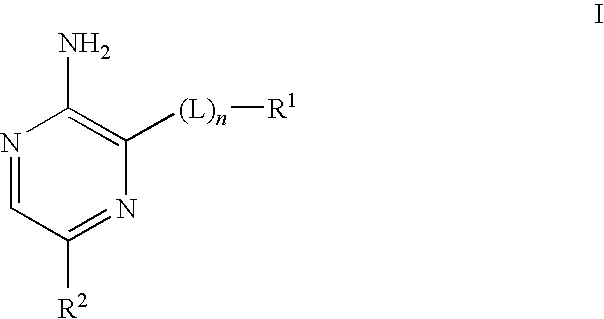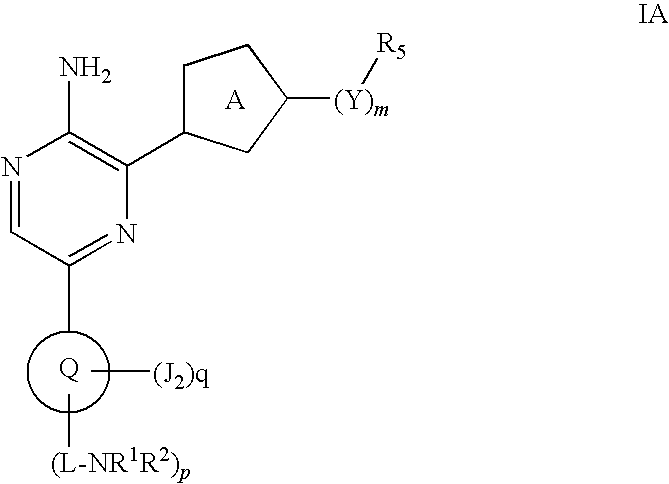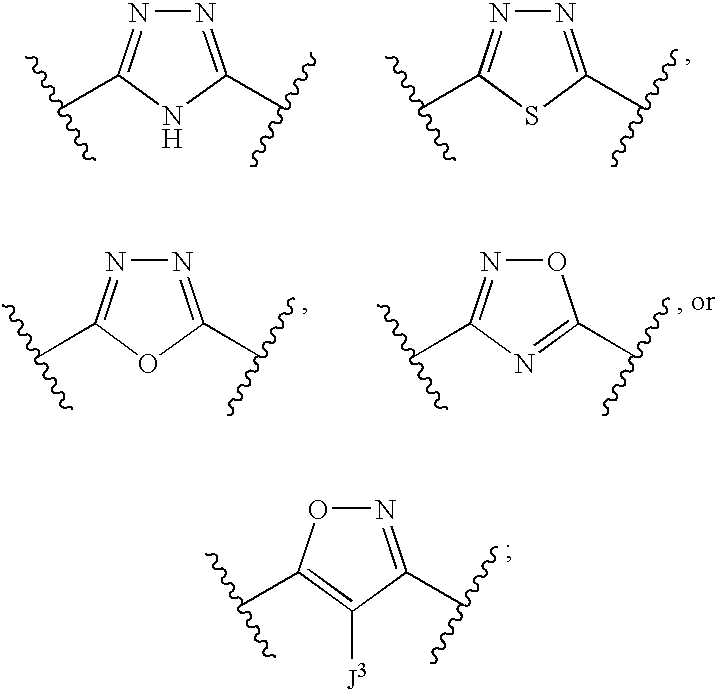Compounds useful as inhibitors of atr kinase
a technology of atr kinase and compounds, applied in the direction of biocide, drug compositions, borehole/well accessories, etc., can solve problems such as dna damage, and achieve the effect of surprising synergy
- Summary
- Abstract
- Description
- Claims
- Application Information
AI Technical Summary
Benefits of technology
Problems solved by technology
Method used
Image
Examples
example 1
3-amino-6-(4-methoxyphenyl)-N-phenylpyrazine-2-carboxamide (Compound I-1)
[0585]
Method A
Step 1: Methyl 3-amino-6-bromopyrazine-2-carboxylate
[0586]
[0587]A mixture of methyl 3-aminopyrazine-2-carboxylate (8.35 g, 54.53 mmol) and N-bromo-succinimide (9.705 g, 54.53 mmol) was stirred in MeCN (100 mL) at room temp overnight. The resultant precipitate was filtered, washed with MeCN and dried to give the desired product as a yellow solid (11.68 g, 92% Yield)
[0588]1H NMR (400.0 MHz, DMSO) 3.85 (s, 3H), 7.55 (br s, 2H) and 8.42 (s, 1H) ppm; MS (ES+) 233
Step 2: 3-amino-6-bromopyrazine-2-carboxylic acid
[0589]
[0590]A mixture of methyl 3-amino-6-bromo-pyrazine-2-carboxylate (5.11 g, 22.02 mmol) and lithium hydroxide (2.637 g, 110.1 mmol) in MeOH (20 mL) and H2O (20 mL) was heated to 90° C. for 2 hours. The reaction mixture was allowed to cool and neutralised with HCl and the resultant precipitate collected by filtration. Taken on to the next step without further purification (4.80 g, 99% Yield).
S...
example 2
(R)-3-amino-N-phenyl-6-(4-(2-(pyrrolidin-1-ylmethyl)pyrrolidine-1-carbonyl)phenyl)pyrazine-2-carboxamide (Compound I-42)
[0661]
[0662]Compound I-42 was prepared by using Method A, Steps 1-3 followed by Method I-B, Steps 1-2.
Method I-B
Step 1: 3-(5-amino-6-(phenylcarbamoyl)pyrazin-2-yl)benzoic acid
[0663]
[0664]A mixture of 3-amino-6-bromo-N-phenyl-pyrazine-2-carboxamide (2.5 g, 8.529 mmol), 3-boronobenzoic acid (1.415 g, 8.527 mmol) and Na2CO3 (1.808 g, 17.06 mmol) was suspended in MeCN (40 mL) / water (40 mL). The mixture was degassed (5×N2 vacuum cycles) and Pd(PPh3)4 (985.6 mg, 0.8529 mmol) added. The mixture was degassed again and heated to 90° C. After 2 hours, the mixture was allowed to cool and concentrated to half its original volume. The resulting yellow precipitate was collected and washed with DCM and water (3.05 g, 86% Yield). 1H NMR (400 MHz, DMSO) d 7.16 (1H, t), 7.38-7.42 (3H, m), 7.64 (2H, br s), 7.81 (2H, d), 7.88 (1H, d), 8.17 (1H, d), 8.46 (1H, d), 8.85 (1H, s), 10.39 (1...
example 3
3-amino-6-(4-(methylsulfonyl)phenyl)-N-phenylpyrazine-2-carboxamide (Compound I-82)
[0716]
[0717]Compound I-82 was prepared using Method A, Step 1 followed by Method I-C, Steps 1-3
Method I-C
Step 1: Methyl 3-amino-6-(4-(methylsulfonyl)phenyl)pyrazine-2-carboxylate
[0718]
[0719]A mixture of methyl 3-amino-6-bromo-pyrazine-2-carboxylate (1.5 g, 6.465 mmol), (4-methylsulfonylphenyl)boronic acid (1.552 g, 7.758 mmol), bis(triphenylphosphine)palladium(II)dichloride (226.9 mg, 0.3233 mmol), and Na2CO3 (9.700 mL of 2 M, 19.40 mmol) in DME (18.75 mL) were heated in the microwave at 110° C. for 1 hour. The resultant mixture was diluted with EtOAc and washed with water. The organic phase was dried over magnesium sulfate, filtered and concentrated in vacuo. The residue was purified on silica gel by flash column chromatography (50% EtOAc / hexanes) to afford the title compound (600 mg, 53% Yield).
[0720]1H NMR (400 MHz, DMSO) 3.25 (3H, s), 3.92 (3H, s), 7.61 (2H, br s), 8.00 (2H, m), 8.26 (2H, m), 9.03...
PUM
| Property | Measurement | Unit |
|---|---|---|
| Fraction | aaaaa | aaaaa |
| Cell death | aaaaa | aaaaa |
Abstract
Description
Claims
Application Information
 Login to View More
Login to View More - R&D
- Intellectual Property
- Life Sciences
- Materials
- Tech Scout
- Unparalleled Data Quality
- Higher Quality Content
- 60% Fewer Hallucinations
Browse by: Latest US Patents, China's latest patents, Technical Efficacy Thesaurus, Application Domain, Technology Topic, Popular Technical Reports.
© 2025 PatSnap. All rights reserved.Legal|Privacy policy|Modern Slavery Act Transparency Statement|Sitemap|About US| Contact US: help@patsnap.com



